15 Aug Bolivia — Down the Andes with a Coca farmer
In La Paz, the Witches’ Market is the happening place for Llama fetuses.
Peg and I weren’t shopping for llama fetuses. But we did have a few days on our hands, and all the brochures mentioned them. So we went to see for ourselves.
I’d seen fetuses at the Durham County Fair, so I had an idea what to expect. But Bolivian fetuses didn’t turn out to be anything like their North-Carolina cousins. In Bolivia, fetuses aren’t clammy blobs floating like boiled eggs in five-gallon jars – at least llama fetuses aren’t. They’re stiff, dried things with long necks that remind you of the toy giraffes you might give a two-year-old.
The Witches’ Market carries more than just supernatural paraphernalia. It’s a, sprawling, general-purpose emporium overflowing with all the stuff that’s going to be at Wal-Mart – just as soon as Wal-Mart makes it to Bolivia – arranged by category on the sidewalks. One block has nothing but baby clothes while, across the street, it’s all hinges and door knobs. Our hotel was down the fluorescent-light alley, just over from the plumbing-supply district. When night fell and the lights switched on, the sky-glow made it easy to find our way back.
One of the streets is travel agents. You can book a reed boat on Lake Titicaca. You can hire a bus to the pre-Inca ruins at Tiwanaku. Or, you can fall under the romantic notion of a gravity-assisted eco-tour bicycle ride down the “World’s Most Dangerous Road.” They supply the bikes and the bus. You supply the bucks and the butts. Peg’s eyes lit up at the prospect.
I started to hyperventilate. A long day jolting down a very bad road didn’t sound like what I’d come to Bolivia to do.
In the end, we compromised. Peg forgot about the World’s Most Dangerous Road, and we rented a car and a guide to take us to the Yunghas. The Yunghas is a high-altitude jungle perched on the eastern slopes of the Andes.
The next morning, we met Santiago.
And El Duque.
“El Duque is a good driver,” Santiago assured us. “One of the best for a road like this.” There was something about the way Santiago said, “a road like this,” that made the tumblers start to rotate in the back of my brain.
“Oh yes, Señor,” Santiago went on. ”For the World’s Most Dangerous Road we use only the best drivers.” That’s when I checked a map.
Bolivia isn’t exactly chock-a-block with infrastructure. In fact, if you want to go anywhere east from La Paz – which is basically the whole continent of South America – you have to take the World’s Most Dangerous Road. There aren’t any other roads. Gravity-assisted eco-biking? World’s Most Dangerous Road. The Yunghas? World’s Most Dangerous Road. Lowland Jungle? World’s Most Dangerous Road. Brazil? Paraguay? Amazon Basin? The World’s Most Dangerous Road. Forty-five minutes later, and almost a mile higher than when we started, we were at El Cumbre.
El Cumbre is a 15,000-foot-high pass over the Andes.
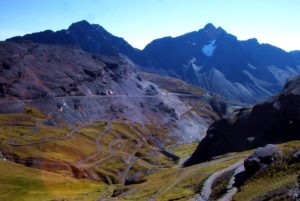
It’s vast and open the way the high prairies of Wyoming are vast and open. It’s also very beautiful, and it has one of those South American statutes of Christ with arms outstretched in that stiff, manufactured way that reminds North-Americans of balsa-wood airplanes.
Since it was Holy Week, the pedestal Christ was standing on was cluttered with shot-glasses and pieces of slate stacked like cards into little houses. The shot glasses were filled with a local rotgut prepared specifically with Jesus in mind. The label comes with a warning against humans drinking the stuff. The slate houses are a form of sympathetic magic . . . 3-D models of the full-blown houses Jesus will to cough up if you get Him drunk enough.
A few thousand feet down the back of the Andes we came to the checkpoint where the World’s Most Dangerous road splits off from the less dangerous road that, someday, will be a better way down the mountains. The Less Dangerous Road was reputed to be three-lane blacktop all the way. It was also reputed to be one tunnel short of completion. How long before that tunnel would open, though, was a matter of conjecture – the story being that the money to finish the project had been grafted away, and the government might never be able to come up with more.
You can see why they need another way to get down. The World’s Most Dangerous Road is one lane – or, in a lot of places, three-quarters of a lane – dirt, rock, dust, mud with no paving at all.
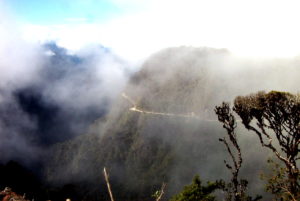
Driving along it is like trying to take a car down the Kaibab mule trail into the Grand Canyon, only without as much room for maneuver. On one side is a wall of granite – or sometimes, dirt – often straight up, often overhanging the road, but always so sheer and so high you couldn’t scramble to the top with a rocket pack. On the other side, clouds. The mountain falls straight down for thousands of feet. And, way too often, so do motorists.
We went down there on the ninety-eighth day of the year. In those 98 days, 43 people had fallen off. If you don’t count roads with land mines or snipers, this might well be the most dangerous road in the world – which is why it’s a good idea to wait until you’re in La Paz to book the trip. I have heard dark stories of American travel agents who refuse to arrange it. In the Witches’ Market, you won’t have that problem.
The checkpoint had the menacing, barren aspect of army posts the world over. Downhill traffic funneled to a stop beside a high platform that looked like it was lashed together out of bamboo. A few-dozen Bolivian soldiers were lounging about in US-issue, drug-war, combat fatigues and body armor. They were carrying automatic weapons and sawed-off shotguns. On the platform, soldiers with machineguns were silhouetted against the sky. There was a little sign announcing NO PICTURES. I can’t speak for Peg, but I had to squelch the impulse to hurl my camera over the cliff.
One thing you realize right away is that the Tom Clancy movies get it right. This place looks exactly the way a drug checkpoint in a remote part of South America is supposed to look – only, nobody checks for drugs. A carload of coca coming uphill will be waived right through. Coca leaves are the Altoids of the Andes – and about as threatening. People chew them for energy, and to put off hunger and thirst. The checkpoint is to stop swimming-pool chemicals from going in the other direction – because hydrochloric acid and water disinfectants turn coca into cocaine.
The whole business about coca is a sore spot. Bolivians know all about our War on Drugs, and they do not approve. Tee-shirts everywhere display the message Coca no es la cocaina. Coca is everywhere too, of course. All us Norteamericanos drank it in the morning boiled into tea, and hardly any of us ran crazy through the streets chopping up grandmothers to get the money for our next cup.
We picked a good day to drive to the Yunghas. The rainy season had ended and there weren’t any landslides. There were mudholes that set three of our 4WD wheels spinning, though; and long, choking, dusty patches that left us unable to see more than a couple of feet ahead; and rocks the size of nursing pigs. Part-way down, the mud and the dust washed off when we had to drive through a waterfall.
My guess is that most of those 43 people who fell off were heading downhill. The uphill traffic is what turned what should be nothing more than the World’s Most Picturesque Road, into the World’s Most Dangerous. Traffic heading uphill not only has the right-of-way, it gets the inside, too. Which meant that every time El Duque spotted something coming toward us, he had to look around for a place to pull to the outside. Then we’d wait, dribbling pebbles into the clouds below
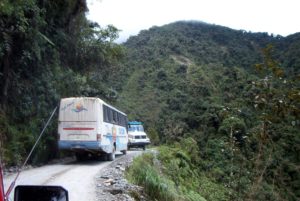
while the truck or bus or whatever lurched past.
After we had bounced and choked and splashed and pulled our way to the outside for about an hour, Peg had one of those profound insights you associate with near-death experiences. “To think”, she said. “For only forty dollars more, we don’t have to bike down this thing.”
A while back, the Bolivian government tried to make the road safer by making it one-way. The plan probably would have worked, except the road had to be one way the other way, too. So, from midnight to noon, everything went downhill. From Noon to midnight, everything came uphill. But instead of making the World’s Most Dangerous Road safer, it turned it into the World’s Most Dangerous Racetrack. Hundreds – maybe, thousands – of rigs collected at the bottom, drivers gunning their motors and waiting for noon. When the flag dropped, they all started up.
There is nothing pleasant about being stuck on a one-lane mountain road in rush-hour traffic. It’s no fun, either, eating dust all the way to the top. So the name of the game became, “Gun that sucker on up the mountain before somebody else does.” With all the bumping and nudging, death rates held steady and, after a while, the government reopened the road to two-way traffic.
When we set out, the valleys below were filled with clouds, and the views were long and flat, the way they are from an airplane. A few thousand feet lower, we were in the clouds – and they weren’t just ephemeral tricks of weather. They were the permanently situated clouds you find pasted all over the Andes at eight or nine-thousand feet – clouds that have become such a feature of the landscape entire ecosystems have grown up inside them. Everything is foggy and romantic and dripping and, from time to time, you can see the shape of a tree fern, or some other huge, prehistoric plant, looming in the mist.
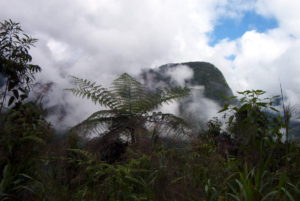
Below the cloud forest, the view opens back up. But it’s drier and the air is hotter and the plants have changed. This is coca country. Stuck on slopes so impossibly steep you would have to take an aerial tram to get to them, are little fields of bushes laid out in neat rows.
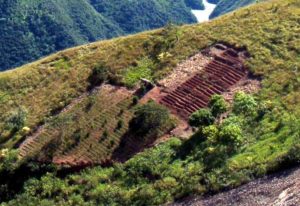
You can get a good view if you’re on foot.
We were on foot because the Land Rover broke down in a way that required new electrical parts. We couldn’t see any car-parts stores anywhere – just and coca farms, and so many butterflies in so many colors it was as if a ribbon factory had exploded – so Peg and Santiago and I left El Duque in charge, and hoofed it downhill.
That’s when Santiago told us the thing about being a coca farmer. He only grew enough leaf for traditional use, he assured us, but he was a little vague as to how much of the stuff got used traditionally. My idea of traditional use cranked up a notch or two every time he referred to his farm as “the plantation.”
Maybe, I thought, traditional use involves some rather large agribusiness enterprises.
Maybe, it occurred to me, the tradition only extends back to the time the Medellin Cocaine Cartel busted up in Colombia, and a brand-new market opened in Bolivia for traditional agricultural products.
No, I thought, a big-time drug lord wouldn’t be a tour guide.
But, maybe, being a guide was just the ticket. Maybe a guide could drive through the checkpoint every day with tourists in a Land Rover and a load of swimming-pool chemicals in back and never be searched.
Maybe, all Santiago had to do was wait for the Land Rover to break down in coca country, then hike away with the tourists and, next time he saw the Land Rover, the pool chemicals would be replaced with processed material.
At the bottom of the World’s Most Dangerous Road we came to a handful of food stands where the road split, again. One direction continued downhill, dropped another mile of altitude, and wound up in the Amazon jungle. The other ran up a longish rise to what was advertised as a gourmet lunch for us in Coroico. We bought a round of Cokes, then walked over to the taxi stand.
I never discovered how taxis could make a living down there. Maybe all the cars carrying tourists break down. Whatever, in about thirty seconds, we were on our way.
Coroico is a charming hill town with pastel buildings and narrow streets
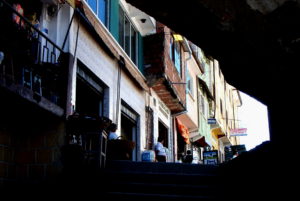
and a tiny town square. Lunch was at a frou-frou place called the Molino Viejo.
Molino Viejo means Old Mill and, just like all the Old Mills in the US, it sports an old-fashioned wooden water wheel to show it’s serious about the name. And, just like you would expect of an Old Mill at home, lunch was a dainty, nouvelle-cuisine sort of affair in a fancy dining room overlooking the pool.
It took me a while to put that together. They had a pool – even though, as far as I could tell, the only swimming-pool chemicals anywhere around were in the hands of drug lords. Maybe drug lords like nouvelle cuisine.
Just as the meal ended, El Duque showed up with the Land Rover. Somehow, he’d found the exact electrical part and the exact roving mechanic right there among the coca farms. We were back at el Cumbre by sunset. Who’d a-guessed?


No Comments